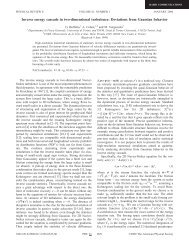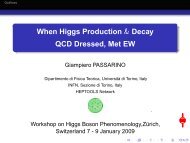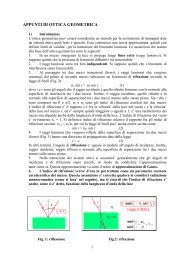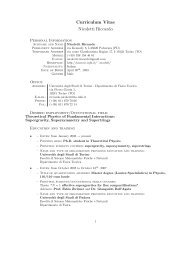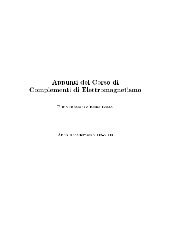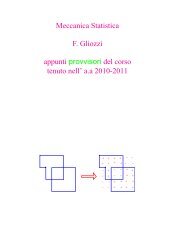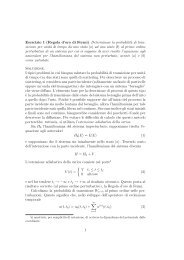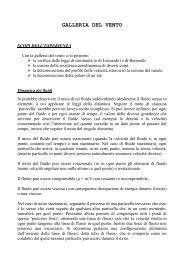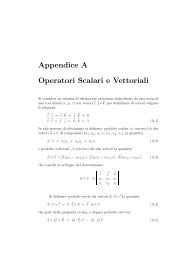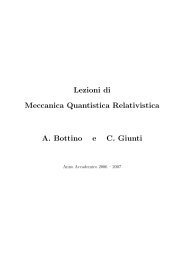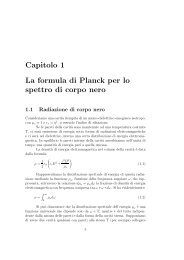Perturbative QCD for LHC Physics - INFN - Torino Personal pages
Perturbative QCD for LHC Physics - INFN - Torino Personal pages
Perturbative QCD for LHC Physics - INFN - Torino Personal pages
You also want an ePaper? Increase the reach of your titles
YUMPU automatically turns print PDFs into web optimized ePapers that Google loves.
<strong>Perturbative</strong> <strong>QCD</strong> <strong>for</strong> <strong>LHC</strong> <strong>Physics</strong>Lorenzo MagneaUniversity of <strong>Torino</strong> - <strong>INFN</strong> <strong>Torino</strong>University of Edinburgh -- February 16, 20111
Outline• Motivation and introductionThe why and how of P<strong>QCD</strong> at <strong>LHC</strong>• Parton distributionsPicking quarks and gluons inside protons• <strong>QCD</strong> JetsThe long road to the calorimeter• Hard scattering cross sectionsN k LO and beyond: where we stand• A Perspective2
Motivation (I)3
Motivation (I)4
Motivation (II)5
Motivation (II)<strong>LHC</strong> is alargeHADRONcollider6
Motivation (III) and Disclaimer7
Motivation (III) and DisclaimerLow-energyHadronic phenomenaConstituent QuarkModelQuark-partonmodelHigh-energyHadronic PhenomenaHadron SpectrumDeep InelasticScattering<strong>QCD</strong>cPTNon<strong>Perturbative</strong><strong>QCD</strong>OPE<strong>QCD</strong> sum rules<strong>Perturbative</strong><strong>QCD</strong>ExclusiveProcessesMatrixModelsInstantonsVacuum StructureLattice1/NEffective TheoriesFinite T, ρStringsMonte CarloHadronizationModelsResummationsand PowerCorrectionsFactorizationTheorems<strong>Perturbative</strong>EvolutionLow-Energy ScatteringHadron SpectrumPhenomenologyU(1) Problem Effective Strings Quark-Gluon PlasmaHigh-Energy ScatteringHeavy QuarksEnergy10 MeV 10 TeV8α SPDF'sJets
P<strong>QCD</strong> Master Formulas⇥ h 1h 2H(S, Q2 ) = ⇤ a,b⌅ 10µ f⌅⌅µ ff a/h (x, µ f ) = ⇤ bdx 1 dx 2 f a/h1 (x 1 , µ f ) f b/h2 (x 2 , µ f ) ⇧⇥ abP⌅ 1xdyy P ab⇥xy , s(µ 2 )f b/h (y, µ f )x 1 x 2 S, Q 2 , µ f⇥Strategy• Choose a factorization scheme.• Compute ⇥ abP (µ 0) <strong>for</strong> process A.• Measure ⇥ H (Q ⇥ µ 0 ) <strong>for</strong> process A.• Determine f a/h (µ 0 ).• Factorization proofs are highly non-trivial.• Soft gluons rearrange partons be<strong>for</strong>e collision.• Correlations are suppressed by powers of Q.• Evolve f a/h (µ 0 ) to the scale µ 1 .• Compute ⇥ abP (µ 1) <strong>for</strong> process B.• Predict ⇥ H (Q ⇥ µ 1 ) <strong>for</strong> process B.10
<strong>QCD</strong> to understand the initial stateParton Distributions11
Parton kinematics• Large mass states are made atlarge x and central rapidities.... though not a light Higgs!• Small x means limited Q 2 .... which implies big uncertainties!• Altarelli-Parisi evolution is up,feeding from the right.• Precise evolution codes areneeded and available... splitting functions are known atthree loops!• <strong>LHC</strong> will measure partondistributions on its own12
Partons from data• Different data sets determine different combinations of parton distributions.• Global constraints imposed by sum rules (momentum, charge, ...).• Strategy: “global fit”. Players: CTEQ, MSTW, NNPDF, ABKM, ...• A highly nontrivial statistical problem!Data set <strong>for</strong> NNPDF 2.0 parton fit.• Photon DIS determines quark +antiquark combinations.• W DIS determines flavordecomposition.• Scaling violations determine small-xgluons.• High p T jets determine large-x gluons.• Drell-Yan p-n asymmetry determinesantiquark asymmetry.• W asymmetry determines quarkasymmetry.• Heavy quark production and evolutiondetermine heavy quark pdfs.13
Parton parametrizations: standard approach• Select a functional <strong>for</strong>m <strong>for</strong> each distribution.f a/h x, µ 2 0⇥= x (1 x) ⇥ P (x, i)• Fit the parameters to experimental data.• Typically: 7 functions, 20-30 parameters,~3000 experimental points.• Characterize fit based on experimentalerrors and correlations.CTEQ tolerance criterion <strong>for</strong> hessian eigenvalues• Per<strong>for</strong>m standard χ 2 analysis with Hessian matrix.• Adjust T 2 = Δ χ 2 so that PDF’s agree with allexperiments to 90% confidence level• Problems:Warning: requires Δ χ 2 >> 1 !χ 2 analysis requires gaussian statisticsdifferent experiments are not always compatibleParametrization rigidity (Pumplin 09)function space not covered by parametrization14
A novel approach: NNPDFGOAL: Provide a faithful representationof the probability distribution in the functionalspace of parton distributions.• Generate N rep Monte Carlo copies ofexperimental data reproducing centralvalues, errors and correlations.• Train N rep neural networks, one on each copyof the data.• Compute any function of PDF’s with its error.⇥⇧F [f a (x)]⌃ = [Df a ] F [f a (x)] P [f a (x)]1N repN repk=1F⇤f(k, net)a⌅(x)F = ⇤F [f a (x)] 2 ⌅ ⇤F [f a (x)]⌅ 2FEATURES:Unbiased sampling of functional space.Very many parameters (250 ~ ∞), allow fitting “any function”Cross-validation prevents overlearning15
Sample distributions with error bandsTriplet and valence quark distributions with uncertainties, linear scale (NNPDF).Gluon distributions with uncertainties, log and linear scale (NNPDF).16
Strange distributions• The strange quark distribution is important.It drives the uncertainty on σ W /σ Z .It influences the determination of CKMparameters V cs and V cd .It affects the NuTeV anomaly.• Previously assumed proportional to lightantiquarks, with vanishing asymmetry.• Now determined using neutrino DIS (NuTeV)and fixed-target Drell-Yan data.NNPDF determinations of the strange asymmetryThe determination of the strange asymmetrysolves the NuTev anomaly.17• There is now 2σ evidence <strong>for</strong> anon-vanishing strange asymmetry• Large uncertainty be<strong>for</strong>e inclusion ofDY data nullified the NuTeV anomaly• Improved determination with DY databrings NuTev determination of Weakangle in line with EW fit.
Caveat EmptorComparison of different CTEQ pdfs <strong>for</strong> <strong>LHC</strong> processes• Parton distributions are the dominantuncertainty <strong>for</strong> “standard candle”processes such as W or Z productionat <strong>LHC</strong>.• The expected uncertainties at <strong>LHC</strong> are afew percent.• A technical change by CTEQ in thetreatment of quark mass thresholds(“ZM-VFN” to “GM-ACOT”) moved thecross section by 2-3 σ.• Smaller heavy quark PDFs by sum rulesimply larger light quark PDFs: thesemake W’s.• MSTW reported a similar increase <strong>for</strong>related (though not identical) reasons.• This illustrates the complexity and impactof PDF uncertainties: they must be wellunderstood!Different predictions <strong>for</strong> Z production at <strong>LHC</strong>18
A parton distribution interface19
<strong>QCD</strong> <strong>for</strong> the observables in the final stateJets20
Jets at Tevatron and <strong>LHC</strong>• Jets are ubiquitous at hadron collidersthe most common high-p T final state• Jets need to be understood in detailtop mass, Higgs searches, <strong>QCD</strong> studies,new particle cascades• Jets at <strong>LHC</strong> are numerous and complicatedtop-antitop-Higgs to 8 jet final state ... ,underlying event, pileup ...• Jets are inherently ambiguous in <strong>QCD</strong>no unique link between hard parton and jet• Jets are theoretically interestingInfrared and collinear safety,resummations, hadronization ...21
Collisions at Tevatron:a cartoon• A proton-antiproton collision producesa top-antitop pair.• Each top quark decays into a bottomquark and a W boson.• One of the W bosons decayshadronically, into a pair of quarks.• The other W boson decays into leptons,yielding a muon with its antineutrino.• All quarks hadronize into jets ofcolorless particles (pions, kaons,protons ...).• The observed final state consists of fourjets, one lepton, and missing energy.22
Collisions at Tevatron: real life23
Real life collisions at <strong>LHC</strong> ...24
... involve many, many jets.Different visualizations of a candidate ten jet event recorded at CMS25
The making of <strong>QCD</strong> jets• Hard partons produced in the collision may emit furtherperturbative hard radiation.Need higher order perturbative calculations.• All hard partons are dressed by soft/collinear radiation.Need parton shower Monte-Carlo.• Parton coalesce <strong>for</strong>ming color singlet hadrons.Need tuned hadronization models.The first <strong>QCD</strong> jets seen by TASSO atPETRA demonstrate gluon radiation• A jet algorithm clusters measured hadrons into jets.It must be stable against soft/collinear emissions• Background radiation not associated with the hardevent must be subtracted.HadronizationUnderlying eventPileup26Single inclusive jet distributionmeasured at Tevatron by CDF
Jet Algorithms• Requirements.Infrared and collinear safety, <strong>for</strong> theoretical (and experimental!) stability.Speed, <strong>for</strong> implementation in simulations and real life.Limited hadronization corrections.• Algorithm structures.Cone algorithms: top-down, intuitive, Sterman-Weinberg inspired.Warning! Infrared/collinear safety issues. Solved by SISCone.Sequential recombination: bottom-up, clustering, adapted from e + e - collisions.Define a distance between partons (hadrons)d (p)ij⇥min k 2pT,i , y k2p ij 2 + 2ijT,jR 2 , d (p)iBk 2pT,i .Choices: p = 1 (k T ) ; p = 0 (Cambridge); p = -1 (Anti-k T )• A lot of recent progress!Gavin Salam et al.: FastJet, SISCone, Anti-kT,Jet Area, Jet Flavor, Analytic Hadronization models.Steve Ellis et al.: SpartyJet.27
Safety of Jet Algorithms: a cartoon28
Safety of Jet Algorithms: a cartoonThree Hard Partons ...29
Safety of Jet Algorithms: a cartoonPick the hardest parton as seed ...30
Safety of Jet Algorithms: a cartoonDraw a cone ...31
Safety of Jet Algorithms: a cartoonSum the momenta to get a new seed ...32
Safety of Jet Algorithms: a cartoonDraw a new cone ...33
Safety of Jet Algorithms: a cartoonIt is stable: call it a jet ...34
Safety of Jet Algorithms: a cartoonNo more partons: algorithm ends35
Safety of Jet Algorithms: a cartoonThere was a collinear splitting!36
Safety of Jet Algorithms: a cartoonPick the hardest parton as seed ...37
Safety of Jet Algorithms: a cartoonDraw a cone ...38
Safety of Jet Algorithms: a cartoonSum the momenta to get a new seed ...39
Safety of Jet Algorithms: a cartoonDraw a new cone ...40
Safety of Jet Algorithms: a cartoonIt is stable: call it a jet ...41
Safety of Jet Algorithms: a cartoonErase the jet partons ...42
Safety of Jet Algorithms: a cartoonPick the hardest remaining parton as seed ...43
Safety of Jet Algorithms: a cartoonDraw a cone ...44
Safety of Jet Algorithms: a cartoonSum the momenta to get a new seed ...45
Safety of Jet Algorithms: a cartoonIt is stable: call it a jet46
Unsafe Jet Algorithms• For Theory: unsafe jet algorithms correspond to theoretical predictions that becomemeaningless beyond a given order.• For Experiment: unsafe jet algorithms yield, event by event, a jet content thatdepends on emission of a soft pion or a highly collinear decay.2⇥ = ⇥ 0 1 + c 1 s + c 2 s + . . . ⇥ . . . c 2 = !⇤ ⌅ ⌅2⇥ = ⇥ 0⇤1 + c 1 s + K log s + . . . = ⇥ 0 (1 + (c 1 + K) s + . . .) .Q• At a minimum, infrared/collinear sensitivity at N P LO destroys the predictivityof a N P-1 LO calculation.• Impact depends on the specific algorithm and observable.The single-inclusive jet cross section is least affected: δσ/σ < 5% comparingSISCone and MidPoint Cone algorithms.Multi-Jet cross sections are severely affected.➡ W + n Jets existing NLO predictions (n = 2,3,4) are not applicable toMidPoint Cone algorithms.➡ For jet mass studies, the overall normalization is affected.47
Comparing Jet AlgorithmsA Les Houches compilation of jet algorithms, see arXiv:0803.067848
Soft gluon effects <strong>for</strong> jetsM. Dasgupta, LM, G. Salam• Jet algorithms cluster particles into “cones” ofradius R on the azimuth-rapidity cylinder.• The jet energy is modified by “splash-in” effectsdue to the underlying event. They grow with R 2 .• The jet energy is modified by “splash-out” effectsdue to soft radiation. They can be estimatedanalytically using soft gluon resummation.• Soft gluon effects grow at small radius, with anon-perturbative coefficient that can be measuredin electron-positron collisions.• The best R can be chosen to minimize unwantedeffects, depending on the measurement.Areas of jets as reconstructed with aninfrared safe clustering algorithm(G. Salam et al.)⇧p t (R)| qq qq= A(µ f )2R C F + 1 8 R ⇤5 C F9N c⌅+ O R 2⇥⌃49
Choosing the best jet radius!"p t # 2 pert + !"p t #2 h + !"p t #2 UE [GeV2 ]987654321!"p t # 2 h!"p t # 2 pertTevatronquark jetsp t = 50 GeV!"p t # 2 UE• <strong>Perturbative</strong> collinear radiation shiftsthe jet transverse momentum bycomputable terms of the <strong>for</strong>m Log R.• The underlying event contributes termsquadratic in R, estimated by Monte-Carlo simulations.• Hadronization effects are proportionalto 1/R, with a coefficient which can beexperimentally determined.• The best choice <strong>for</strong> R can be studieddepending on machine energy, jet flavor,and on the goals of the measurement.00.4 0.5 0.6 0.7 0.8 0.9 1 1.1RShifts in transverse momentum <strong>for</strong> a 50 GeVquark jet, due to perturbative radiation,underlying event, and hadronization.50• Tuning the jet radius is important at<strong>LHC</strong>, where multijet events arecommonplace, and are used <strong>for</strong> verydifferent analyses.
Jet substructureDetailed control of IR safe jet algorithms allows to study the way particles and energyare distributed inside a given jet: jet substructure.At <strong>LHC</strong> “heavy’’ particles such as Higgs bosons and top quarks can be produced ina highly boosted state, and decay products can <strong>for</strong>m a single jet.Jet substructure analysis with filtering (Butterworth et al. 2008)• Identify a candidate “fat” jet (R > 1).• Undo the clustering until a steep mass drop is found:two subjets are identified.• Recluster with smaller jet radius to drop extraradiation (“filtering”).• Several similar techniques are used(“pruning”, “trimming”, “grooming”, ...).• Event shapes controlling the energy flow inside jets(jet shapes, templates) are also used.51• A light Higgs produced with aZ (W) and decaying to b quarkscan be identified with 30 ' -1 .• Boosted top tagging is alsosignificantly improvedBoosted Higgs identification (Butterworth et al.)
Computing the hard scattering <strong>QCD</strong> cross sectionHigher Orders52
Order by order: LOOr: when is a problem “solved”?• Computing tree amplitudes in gauge theories is a nontrivial problem .• Quantum number management helps.A tree (1, 2, . . . , n) = g n 2 ncpTr (T a1 T a2 . . . T an ) A tree (1, 2, . . . , n)A tree ( , , +, . . . , +) = i⇤12⌅ 4⇤12⌅⇤23⌅ . . . ⇤n1⌅• The problem has a recursive solution.Berends-Giele recursion relations 20 years old and still fastest.Twistor-inspired methods lead to new insights, new recursion relations (BCFW).Factorial complexity degraded to power law (t n ~ n 4 ), except <strong>for</strong> color.• LO calculations are clearly not enough <strong>for</strong> quantitative <strong>LHC</strong> phenomenology!53
Order by order: NLOLight after the bottlenecks• Bottleneck #1: computing loop integrals.Obstacles: analytic structure, tensor integral decomposition.State of the art: 5 points “standard”, 6 points “frontier”.Impressive progress with unitarity + “twistor” techniques.• Bottleneck #2: subtracting infrared and collinear poles.Combine (n+1)-parton trees with n-parton one-loop amplitudes.Compute singular phase space integrals <strong>for</strong> generic observables.General methods exist: slicing, subtraction, dipole.• Bottleneck #3: interfacing with parton shower MonteCarlo’s.Practical usage of a theory calculation requires four steps.ME → generator → shower → hadronization MCNew problem at NLO: double counting of first IR/C emission.Methods are available (MC@NLO, POWHEG), implementations in progress.54
Beyond Feynman diagrams: unitarity• An old technique in QFT: reconstruct a g-loop amplitude from its imaginary part,which is given by (g-1)-loop amplitudes (Landau, Cutkosky, ...).• New developments with modern techniques <strong>for</strong> massless gauge theoriesBern Dixon, Dunbar, Kosower (94), Britto, Cachazo, Feng, Witten (05).• A simple breakthrough: complex momenta allow<strong>for</strong> non-vanishing on-shell three-particle amplitude.• Multiple unitarity cuts express discontinuities ofthe amplitude as products of lower-loop amplitudes.• An iterative structure builds up linking loopamplitudes to Born amplitudes.55
Unitarity and automation at NLO• Unitarity is not sufficient to solve the problem, even at NLO.• A second cornerstone: a basis <strong>for</strong> scalar integrals is known.For any number of particles, no polygons beyond boxes.All relevant integrals are known analytically around d = 4.The problem is now algebraic: compute the coefficients of the expansion.• A third cornerstone: per<strong>for</strong>m the reduction numerically at the integrand levelOssola, Papadopoulos, Pittau (06).Decompose the integrand as in the basis by partial fractioning.Compute coefficients numerically by selecting special values of momenta.Completely algorithmic <strong>for</strong> general NLO calculations.56
NLO factoriesNLO calculations are know automated and being interfaced to event generators andparton showers: the ef<strong>for</strong>t has reached the industrial stage.A partial Les Houches wishlist, on its way to being fulfilledBrands competing on the market:Blackhat (d=4 unitarity + SHERPA)Rocket (d dimensional unitarity + OPP)Golem (Feynman diagrams)CutTools (OPP + HELAC)57
The NLO frontier: V + 4 jetsThe first NLO <strong>QCD</strong> computation with a five-particlefinal state (leading color approximation)(Blackhat Collaboration 2010).• Background to top production, SUSY searches ...• Fully exclusive distributions available.• Infrared subtractions per<strong>for</strong>med with Sherpa.A representative Feynman diagramp T distributions of the leading 4 jets at the <strong>LHC</strong>, with 7 TeV CM energy.58• A truly multi-scale <strong>QCD</strong>problem: needs a carefulchoice of renormalizationand factorization scales.• Scale dependence issignificantly reduced• NLO corrections at the20-30% level <strong>for</strong> typicaldistributions
Order by order: NNLODeep in the dark bottlenecks• Bottleneck #1: computing loop integrals.Obstacles: analytic structure, tensor integral decomposition.However: a basis of scalar integrals is not known (Kosower et al., in progress!).State of the art: “nearly massless” 4-point amplitudes.Ingredients <strong>for</strong>: jet production at NNLO.Exclusive distributions at NNLO are known only <strong>for</strong> quantities withjust one detected particle in the final state (DY, W-Z-H production).• Bottleneck #2: subtracting infrared and collinear poles.Combine (n+2)-parton trees with (n+1)-parton one-loop amplitudes and withn-parton two-loop amplitudes.Several groups working on a general subtraction method.Only one calculation completed to date: NNLO e+e- → 3 Jets.Gehrmann et al. (07), Weinzierl (08)• Bottleneck #3: interfacing with parton shower MonteCarlo’s.Hic Sunt Leones . . .59
NNLO: a teaserNNLO rapidity distributions <strong>for</strong> Z and W production at <strong>LHC</strong> (Anastasiou et al. (03))• Even <strong>for</strong> inclusive quantities, 50-100% <strong>QCD</strong> corrections are common.• “K factors” in general are not factors, distributions change shape.• Theoretical uncertainties are greatly reduced.• NNLO perturbative accuracy of order 1%: luminometry possible at <strong>LHC</strong>parton distributions dominate the uncertainty.60
Computing the hard scattering <strong>QCD</strong> cross sectionAll Orders61
Soft gluon phenomenology at colliders66 < Q < 116 GeVCDF• The cross section peaks in a regiondominated by multiple soft gluonradiation.• Soft gluon effects can be computedto all orders in perturbation theory.• They are necessary to understandqualitatively and quantitatively manydistributions near kinematic limits.• Infrared and collinear singularities ofamplitudes turn into logarithms ofratios of kinematic scales.• Resummation of Sudakov (double)logarithms dominates <strong>for</strong> q T
Infrared divergences to all orders• Infrared singularities <strong>for</strong> any massless gauge theoryamplitude are given by correlators of Wilson lines.• Infrared singularities factor and exponentiate in termsof a matrix of anomalous dimensions.Mp ⇥iµ , s(µ 2 ), ⇥= Z p ⇥i, s(µ 2 f ), ⇥µ fHp iµ , µ ⇥fµ , s(µ 2 ), ⇥,Z⇤ ⌅pi, s(µ 2 f ), ⇥µ f= P exp⇧12⌥ µ2f0d⇤ 2⇤ 2p⇥ ⌃i⇤ , s(⇤ 2 , ⇥) ,• The soft anomalous dimension matrix can be computeddirectly in terms of special diagrams: “eikonal webs”.A “web” diagram contributing to thesoft anomalous dimension matrix.An all-order <strong>for</strong>mula valid <strong>for</strong> any number of external legs and to all orders has beenconjectured (Becher, Neubert 09; Gardi, LM 09).dip⇤ pi⌅⇤ , s(⇤ 2 ) = 1 4 ⇥ K s(⇤ 2 ) ⇥ ⌥j=i⇧ln632 pi · p j⇤ 2⌃T i · T j +n⌥i=1⇥ Ji s(⇤ 2 ) ⇥ .
Perspective• The motivation provided by <strong>LHC</strong> has lead to great progressExpected Signal/Background ratios tell us we need total control of the SM• <strong>Perturbative</strong> <strong>QCD</strong> is now predictive to a few % accuracyA massive challenge <strong>for</strong> a confining non-abelian gauge theory has been met• Many theorists have been converted to an industrial ef<strong>for</strong>tParton Distribution Factories, NLO Brands, Monte Carlo Marketing ...• Surprising progress in QFT, not just phenomenologyCompletely new techniques have emerged, and connections beyond QFT• <strong>QCD</strong> is ready to meet the challenge of real data!64
Thanks to:Stefano Forte, Nigel Glover, Massimiliano Grazzini, Fabio Maltoni,Michelangelo Mangano, Gavin Salam, Tim Stelzer ...Thanks <strong>for</strong> your attention!67




